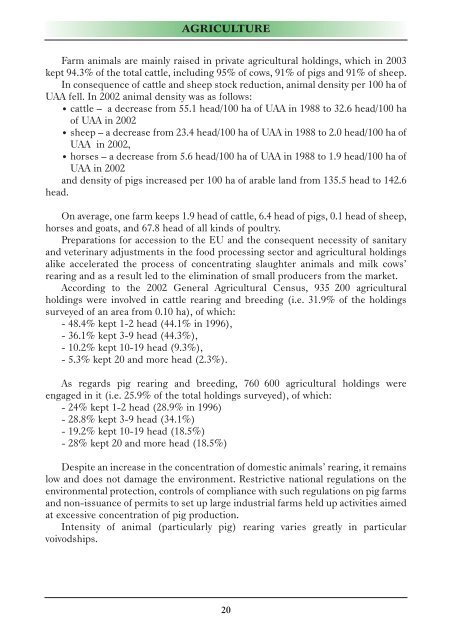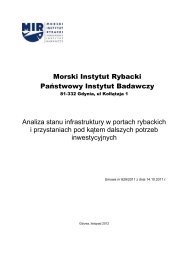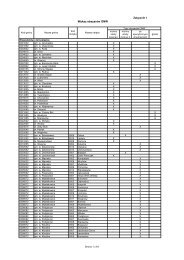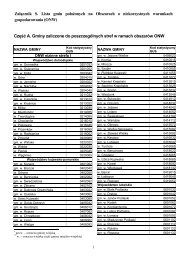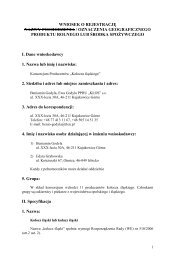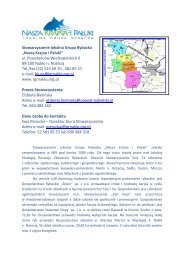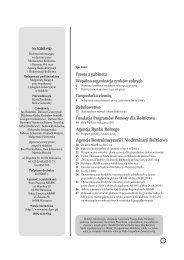agriculture and food economy in poland
agriculture and food economy in poland
agriculture and food economy in poland
You also want an ePaper? Increase the reach of your titles
YUMPU automatically turns print PDFs into web optimized ePapers that Google loves.
AGRICULTURE<br />
Farm animals are ma<strong>in</strong>ly raised <strong>in</strong> private agricultural hold<strong>in</strong>gs, which <strong>in</strong> 2003<br />
kept 94.3% of the total cattle, <strong>in</strong>clud<strong>in</strong>g 95% of cows, 91% of pigs <strong>and</strong> 91% of sheep.<br />
In consequence of cattle <strong>and</strong> sheep stock reduction, animal density per 100 ha of<br />
UAA fell. In 2002 animal density was as follows:<br />
• cattle – a decrease from 55.1 head/100 ha of UAA <strong>in</strong> 1988 to 32.6 head/100 ha<br />
of UAA <strong>in</strong> 2002<br />
• sheep – a decrease from 23.4 head/100 ha of UAA <strong>in</strong> 1988 to 2.0 head/100 ha of<br />
UAA <strong>in</strong> 2002,<br />
• horses – a decrease from 5.6 head/100 ha of UAA <strong>in</strong> 1988 to 1.9 head/100 ha of<br />
UAA <strong>in</strong> 2002<br />
<strong>and</strong> density of pigs <strong>in</strong>creased per 100 ha of arable l<strong>and</strong> from 135.5 head to 142.6<br />
head.<br />
On average, one farm keeps 1.9 head of cattle, 6.4 head of pigs, 0.1 head of sheep,<br />
horses <strong>and</strong> goats, <strong>and</strong> 67.8 head of all k<strong>in</strong>ds of poultry.<br />
Preparations for accession to the EU <strong>and</strong> the consequent necessity of sanitary<br />
<strong>and</strong> veter<strong>in</strong>ary adjustments <strong>in</strong> the <strong>food</strong> process<strong>in</strong>g sector <strong>and</strong> agricultural hold<strong>in</strong>gs<br />
alike accelerated the process of concentrat<strong>in</strong>g slaughter animals <strong>and</strong> milk cows’<br />
rear<strong>in</strong>g <strong>and</strong> as a result led to the elim<strong>in</strong>ation of small producers from the market.<br />
Accord<strong>in</strong>g to the 2002 General Agricultural Census, 935 200 agricultural<br />
hold<strong>in</strong>gs were <strong>in</strong>volved <strong>in</strong> cattle rear<strong>in</strong>g <strong>and</strong> breed<strong>in</strong>g (i.e. 31.9% of the hold<strong>in</strong>gs<br />
surveyed of an area from 0.10 ha), of which:<br />
- 48.4% kept 1-2 head (44.1% <strong>in</strong> 1996),<br />
- 36.1% kept 3-9 head (44.3%),<br />
- 10.2% kept 10-19 head (9.3%),<br />
- 5.3% kept 20 <strong>and</strong> more head (2.3%).<br />
As regards pig rear<strong>in</strong>g <strong>and</strong> breed<strong>in</strong>g, 760 600 agricultural hold<strong>in</strong>gs were<br />
engaged <strong>in</strong> it (i.e. 25.9% of the total hold<strong>in</strong>gs surveyed), of which:<br />
- 24% kept 1-2 head (28.9% <strong>in</strong> 1996)<br />
- 28.8% kept 3-9 head (34.1%)<br />
- 19.2% kept 10-19 head (18.5%)<br />
- 28% kept 20 <strong>and</strong> more head (18.5%)<br />
Despite an <strong>in</strong>crease <strong>in</strong> the concentration of domestic animals’ rear<strong>in</strong>g, it rema<strong>in</strong>s<br />
low <strong>and</strong> does not damage the environment. Restrictive national regulations on the<br />
environmental protection, controls of compliance with such regulations on pig farms<br />
<strong>and</strong> non-issuance of permits to set up large <strong>in</strong>dustrial farms held up activities aimed<br />
at excessive concentration of pig production.<br />
Intensity of animal (particularly pig) rear<strong>in</strong>g varies greatly <strong>in</strong> particular<br />
voivodships.<br />
20


